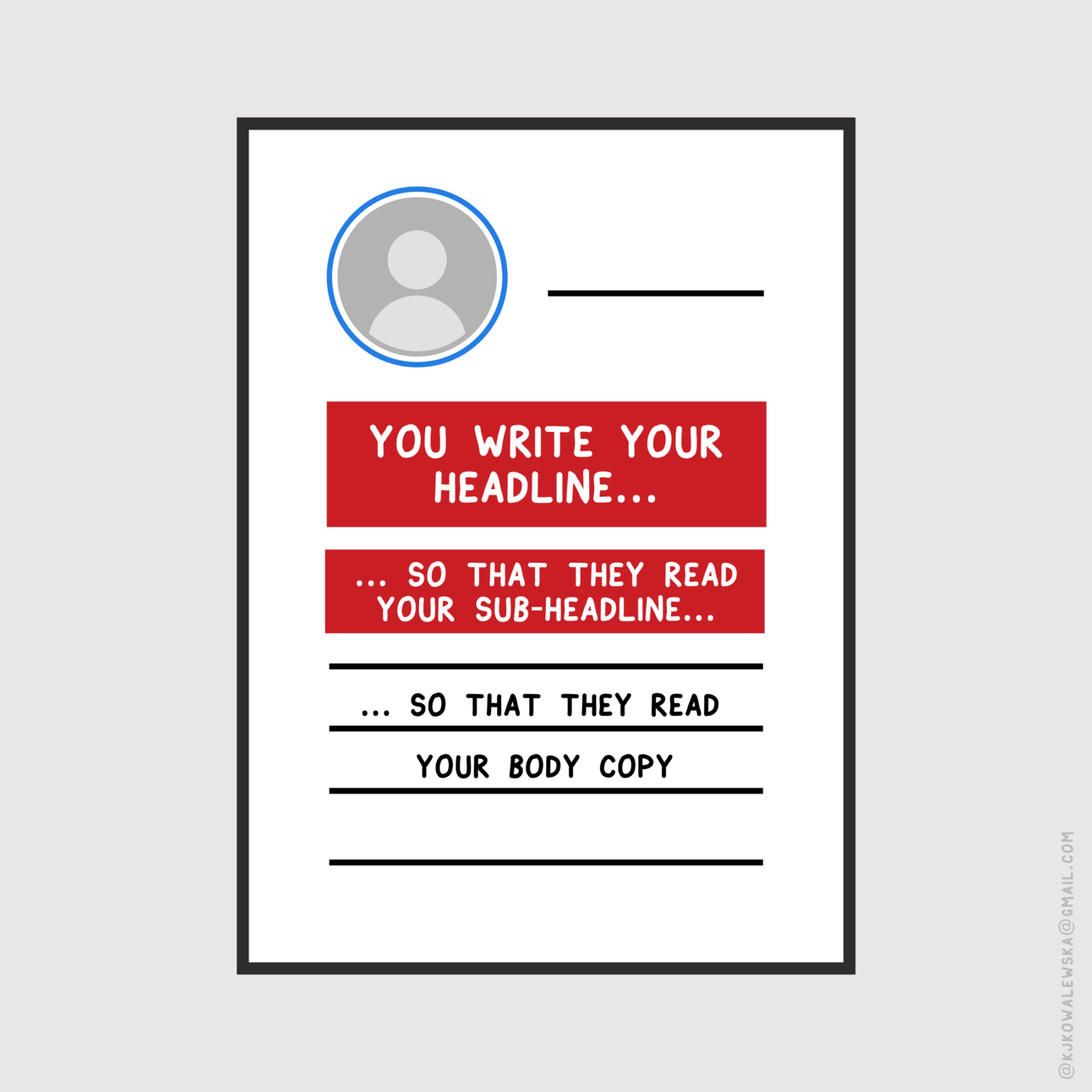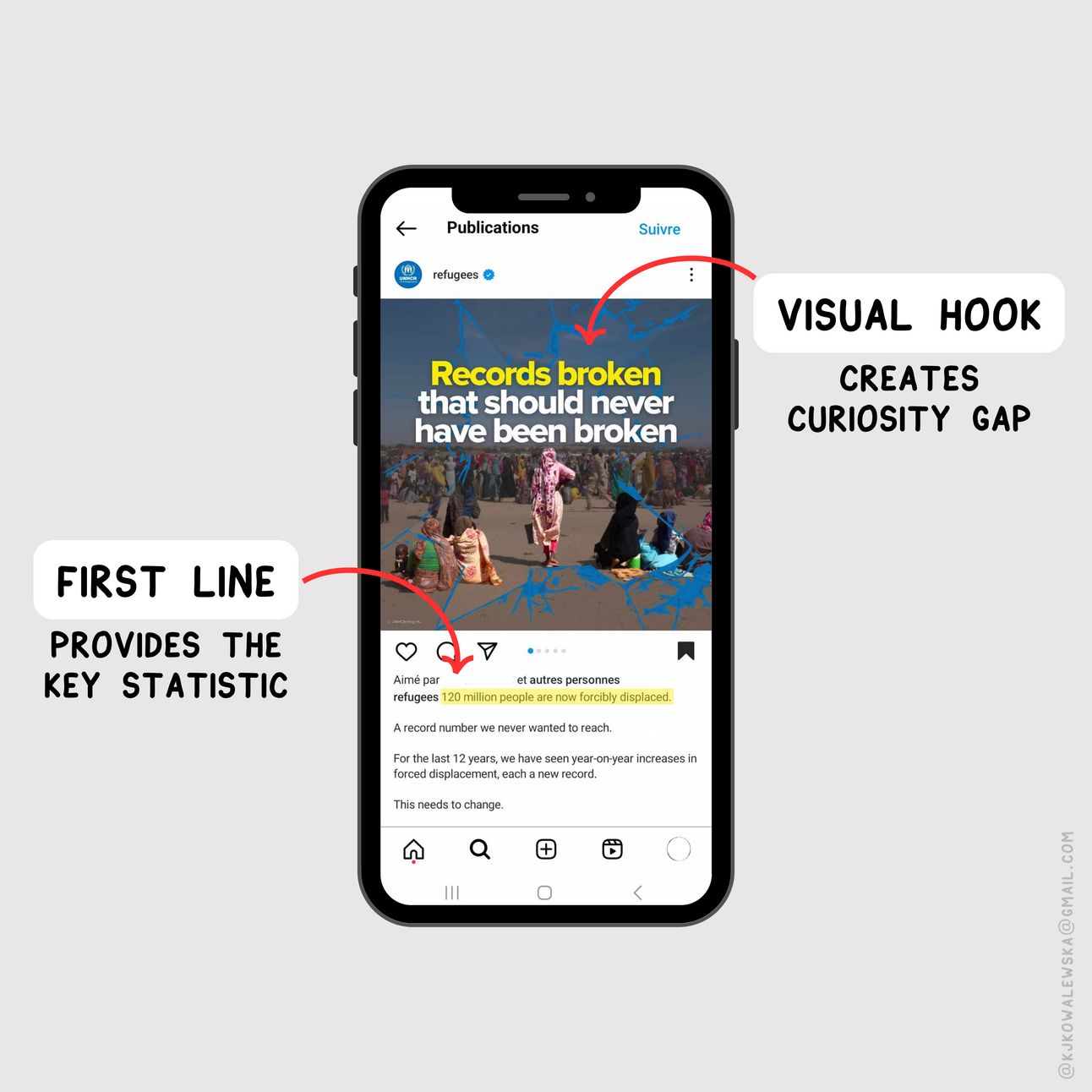- Notes from Kasia
- Posts
- 👀 You’re (probably) overlooking this...
👀 You’re (probably) overlooking this...
...key element in your social posts
Read time: 5 minutes.
Our social media feeds are battlefields for attention.
Everything we do as social media managers is about getting people to stop scrolling. If your content doesn't capture attention, that's pretty much the end of it.
One way to get and sustain attention is to master the first line of your social media caption.
But what about visuals and videos? you may ask.
Yep, social media is increasingly visual-centric, and the visual hook you use can make or break your post. But captions are just as important. And yes, people DO read them.
The reason why you write your headline is so that they read your sub-headline, and the reason why you write your sub-headline is so that they read your body copy.
As the father of modern-day advertising, Ogilvy knew what he was talking about.
Your first line isn't just an introduction.
It sets the stage for the rest of any interaction.

Your first line is more than just an introduction.
Imagine your caption is like a book: if the first chapter doesn't captivate you, you won't stick around for the rest.
In social media, you can have a valuable post and a compelling CTA, but you need to be able to get your audience to that point.
If you hook people in, you’ve already won over half the battle.
The bad news is that there's no magic formula for a great first line, but we can test, learn, and keep improving.
Below, you’ll find six of my tips on the art of the first line.
Start with stepping into the shoes of your audience. They’re scrolling, hurrying, searching for interesting content, being restless, bored, or impatient. If your first line is too much work to understand, they’ll move on. Who has the time and patience to guess what you mean?
Look at how your first line interacts with the rest of your post, especially with the visual hook if you use an image or video. They should constitute a whole, complement and reinforce each other. Stay with me - I’ll show you an example in the next section of this newsletter.
Your goal isn’t to stuff as many words as possible into that space before “Read more”. It’s to make the words you use as compelling as possible. Experiment with simple language, and add some rhythm: long sentence - short sentence, question - answer.
Don’t limit yourself. Your first line can be composed of anything like a piece of text (as short as a word), an emoji, or an insight (like statistics or a point of view).
If a social media post is a conversation with our readers, what easier way to engage with readers than asking them a question? The key is to avoid questions that can be answered by “yes” or “no” - people will keep scrolling. Instead, ask those that will make your reader think, that create a “Wait… what?” reaction, or that sound like the beginning of a story.
A catchy first line is different from a clickbait. Your headline is a promise that you have to deliver. If you don’t, people won't trust you again.
Keep collecting the first lines that caught your own eye. Analyse them, take screenshots, save them in one folder, and browse them for inspiration.
This UN Refugee Agency post is an excellent example of how the visual hook can interact with the first line.
Let’s have a closer look at it.

Master matching your visual hook with the first line.
The visual hook in the post is an excellent attention grabber. It creates a curiosity gap - the gap between what we know and what we want to know.
When we notice a gap in our knowledge, we feel depleted, which prompts us to look for the missing information to alleviate the feeling.
Now, look at the post again.
Records are about going beyond what we thought possible. In sports, talking about records is just as fun as watching them break (👋 to everyone who, like me, will follow the Olympics in Paris).
If so, what records were broken that should never have been broken? We read this hook and want to know more - we continue interacting with the post.
The caption’s first line perfectly complements the visual hook. It builds on this, providing data on the key record that should never have been broken: “120 million people are now forcibly displaced.”
💡 Extra tip: Pay attention to how well the visual headline is optimised for small screens, and how using two colours improves its readability.
*This is a new section inspired by Ana, a reader of this newsletter. Do you have a social media post you want us to dissect together? Send me a link by replying to this newsletter.
🧰 Toolbox
A first line is only as good as its writer. Mastering it takes a lot of practice, and trying and testing is key.
One tool I have experimented with is the Emotional Marketing Value (EMV) Headline Analyzer. It can help you measure your headline's emotional impact.
Why does that impact matter? If you can connect to people's emotions, it makes them feel like you are speaking to them. They’re more eager to interact with your content.
The EMV Index is an algorithm that evaluates how likely a group of words is to provoke an emotional response from readers. The tool also indicates which emotion your customer's headline most impacts.
Do you use any tools to analyse your headlines?
If yes, hit reply or DM me on LinkedIn and let me know how it resonated with you.
I'd love to hear about the struggles you're facing in your social media communication.
What topics can I cover to help you specifically?(Click one) |
I want to create more valuable content for you.
Have a great rest of summer and until next month,
— Kasia
P.S. If you like this newsletter and want to support it, forward it to another EU communicator with an invitation to subscribe right here: https://notesfromkasia.beehiiv.com/subscribe.
Reply